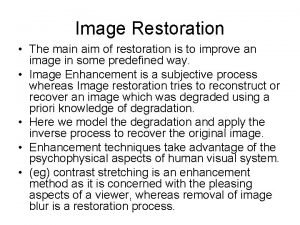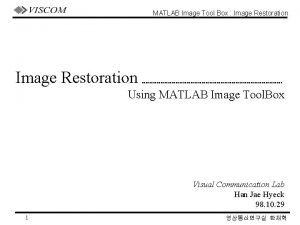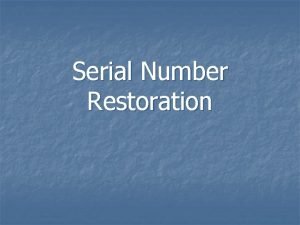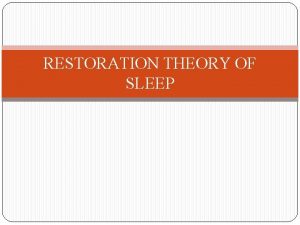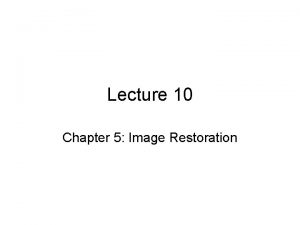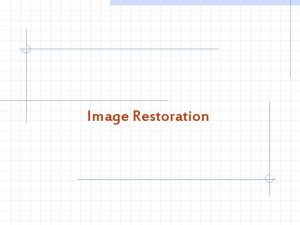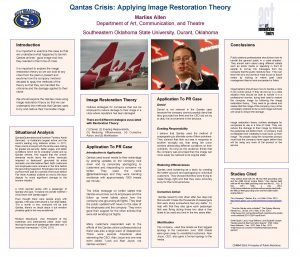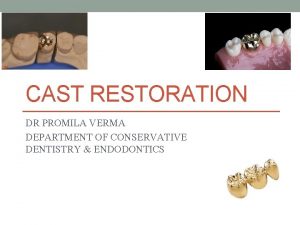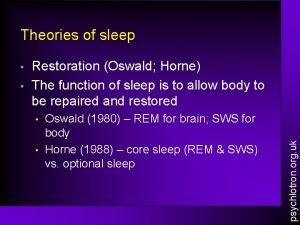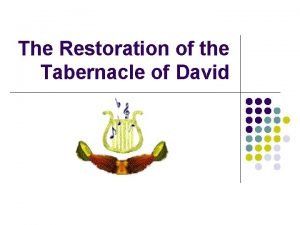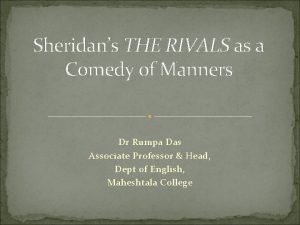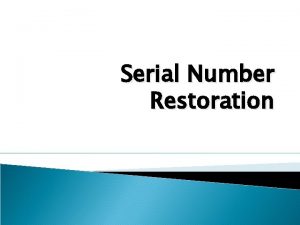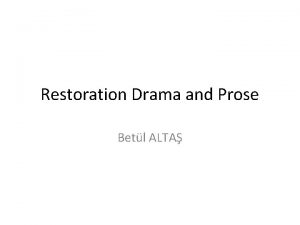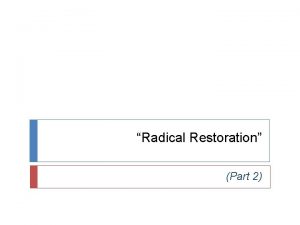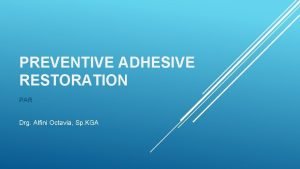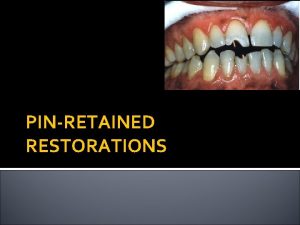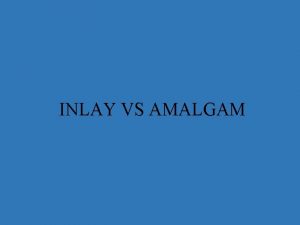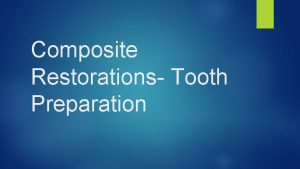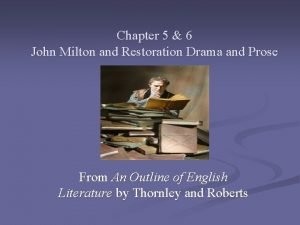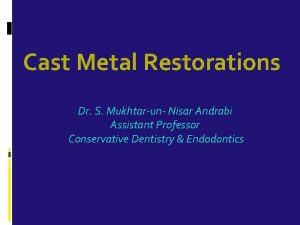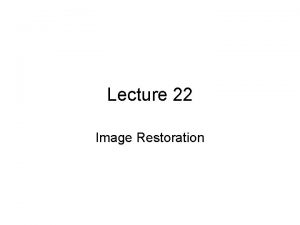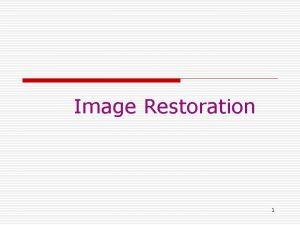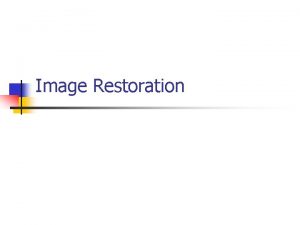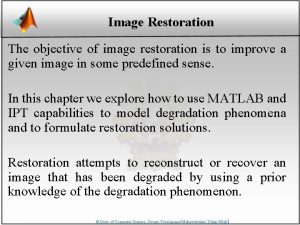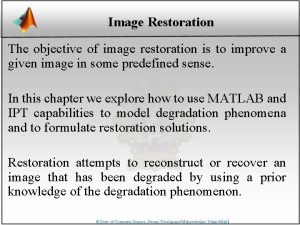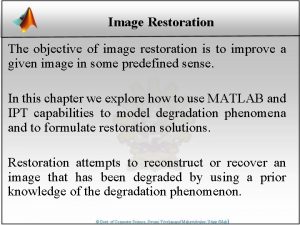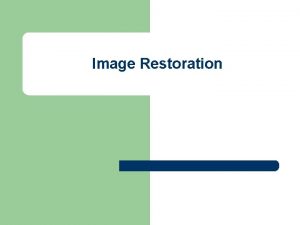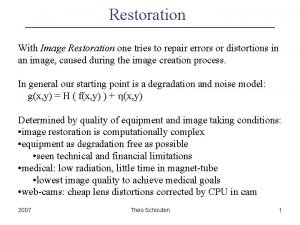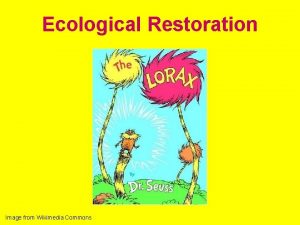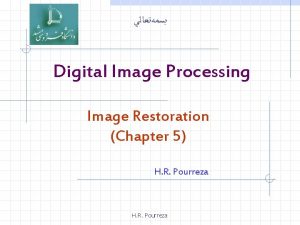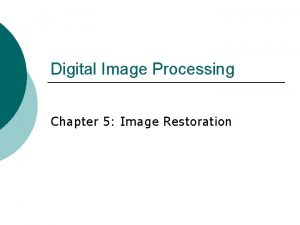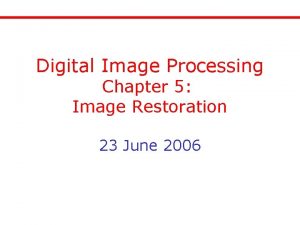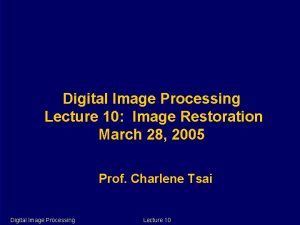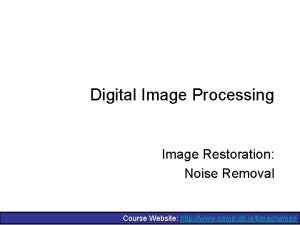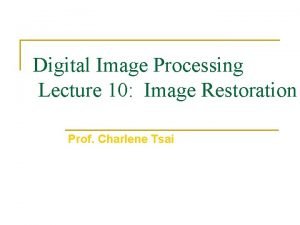Chapter 8 Image Restoration Types of image degradations




































- Slides: 36

Chapter 8: Image Restoration ○ Types of image degradations: Noise, error, distortion, blurring, etc. Degradation model: where g(x, y): degraded image, f(x, y): true image, h(x, y): degradation process n(x, y): additive noise 8 -1

○ Two ways to recover image degradations: 1) Image enhancement: Overlook degradation processes, deal with images intuitively 2) Image restoration: Known degradation processes; model the processes and reconstruct images based on the inverse model 8 -2

○ Start with the degradation model Fourier transform From the convolution theorem, Difficulties: (a) Unknown N(u, v), (b) Small H(u, v) 8 -3

◎ Types of Noises: ○ White noise: the noise whose Fourier spectrum is constant ○ Periodic noise: Original image Noisy image ○ Additive noise: each pixel is added a value (noise) chosen from a probability distribution 8 -4

• Salt-and-pepper (impulse) noise Let x : noise value (a, b can be + or -) 8 -5

• Uniform noise: (a, b can be + or -) 8 -6

8 -7

Given histogram h 8 -8

• Gaussian noise: 8 -9

Method 1: 2 -10

Method 2: 2 -11

• Rayleigh noise: 8 -12

• Erlang (gamma) noise: 8 -13

• Exponential noise: 8 -14

◎ Estimation of noise parameters Steps: 1. Choose a uniform image region 2. Compute histogram 3. Compute mean and variance 4. Determine the probability distribution from the shape of 5. Estimate the parameters of the probability distribution using 8 -15

Examples: (a) Uniform noise: Given 8 -16

(b) Rayleigh noise: Given 8 -17

○ Multiplicative noise: Each pixel is multiplied with a value (noise) chosen from a probability distribution, e. g. , speckle noise 8 -18

◎ Noise removal ○ Salt-and-pepper noise – high frequency image component low-pass filter median filter 8 -19

。 Mean filter (i) Arithmetic mean: 4× 3 5× 5 8 -20

(ii) Geometric mean: (iii) Harmonic mean: (iv) Contraharmonic mean: 8 -21

3 × 3 median filter 3 × 3 (twice) 5× 5 8 -22

。Adaptive filter -- change characteristics according to the pixels under the window 8 -23

3× 3 5× 5 7× 7 9× 9 8 -24

○ Gaussian noise Assume Gaussian noise n(x, y) is uncorrelated and has zero mean Image averaging: 8 -25

Example: 8 -26

Periodic noise Band reject filter Notch filter 8 -27

In general case, Fourier spectrum noise Corresponding spatial noise 8 -28

○ Inverse filtering 8 -29

Low-pass Filtering: Constrained Division d = 40 60 80 100 8 -30

○ Wiener filtering -- Considers both degradation process and noise Idea: The derivation leads to (Parametric Wiener filter) 8 -31

(Wiener filter) When r = 1, If noise is zero, , (Inverse filter) If noise is white noise, is constant 8 -32

Input image k = 0. 001 k = 0. 00001 8 -33

○ Motion debluring Image f(x, y) undergoes planar motion : the components of motion T: the duration of exposure Fourier transform, 8 -34

Shifting property: 8 -35

Suppose uniform linear motion: Restore image by the inverse or Wiener filter 8 -36
 Linear position invariant degradation
Linear position invariant degradation Image restoration is to improve the dash of the image
Image restoration is to improve the dash of the image Noise
Noise Image sharpening in digital image processing
Image sharpening in digital image processing Image restoration matlab
Image restoration matlab Serial number mystery solved by forensic
Serial number mystery solved by forensic Restoration theory of sleep
Restoration theory of sleep Chapter 5 images
Chapter 5 images Image restoration adalah
Image restoration adalah Image restoration theory
Image restoration theory Types of cast restoration
Types of cast restoration Chapter 56 conservation biology and restoration ecology
Chapter 56 conservation biology and restoration ecology Phosphorus cycle pearson education
Phosphorus cycle pearson education Chapter 55 ecosystems and restoration ecology
Chapter 55 ecosystems and restoration ecology Brass v drape
Brass v drape Oswald's restoration theory of sleep
Oswald's restoration theory of sleep Kingdom tabernacle of restoration
Kingdom tabernacle of restoration Meiji restoration
Meiji restoration Meiji restoration samurai
Meiji restoration samurai Rivals as comedy of manners
Rivals as comedy of manners Obliterated serial number
Obliterated serial number San joaquin river restoration program
San joaquin river restoration program Restoration drama and prose
Restoration drama and prose Restoration colonies
Restoration colonies Radical restoration
Radical restoration Restoration par
Restoration par Pin retained restoration
Pin retained restoration Disaster restoration buchanan county
Disaster restoration buchanan county Nyc doe restoration of health leave
Nyc doe restoration of health leave Gulfport restoration company
Gulfport restoration company Shogunate
Shogunate Meiji restoration
Meiji restoration Difference between amalgam and inlay
Difference between amalgam and inlay Beveled conventional
Beveled conventional Restoration prose
Restoration prose Skirts in cavity preparation
Skirts in cavity preparation Cast metal restorations
Cast metal restorations

